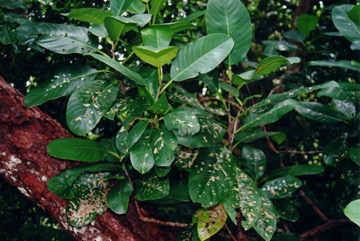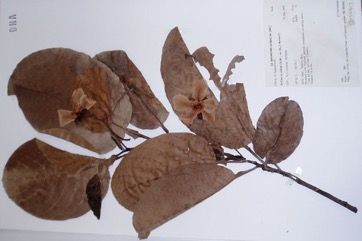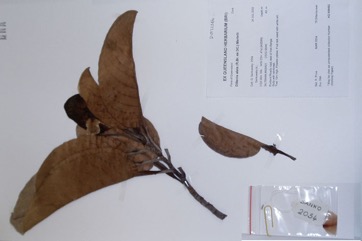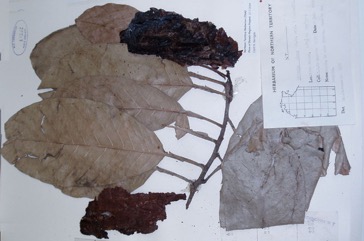Red beech, Golden Guinea Tree, Queensland red beech

A tropical plant. It occurs in dense coastal monsoon forest near freshwater streams. It needs adequate moisture and a well drained soil. It suits a humid place. It is drought and frost tender. In the Cairns Botanical Gardens. It suits hardiness zones 10-12.
Synonyms
- Wormia alata DC.
Edible Portion
- Fruit, Seeds
Where does Red beech grow?
Found in: Australia, Malaysia, Malesia, Pacific, Papua New Guinea, PNG
Notes: There are about 60 Dillenia species.
Status: The seeds are eaten especially by children.
Growing Red beech, Golden Guinea Tree, Queensland red beech
Cultivation: It can be grown from fresh seeds. It can also be grown from cuttings.
Edible Uses: The seeds are eaten raw especially by children. The white fleshy part of the fruit (aril) can be eaten.
Production: It is a fast growing tree. In Australia flowering is in October to January and fruit occur in October to November. (September to February).
Nutrition Info
per 100g edible portion| Edible Part | Energy (kcal) | Protein (g) | Iron (mg) | Vitamin A (ug) | Vitamin c (mg) | Zinc (mg) | % Water |
|---|---|---|---|---|---|---|---|
| - | - | - | - | - | - |
Red beech, Golden Guinea Tree, Queensland red beech Photos




References
Barwick, M., 2004, Tropical and Subtropical Trees. A Worldwide Encyclopedic Guide. Thames and Hudson p 145
Beasley, J., 2011, Plants of Tropical North Queensland - the compact guide. Footloose publications. p 25
Bodkin, F., 1991, Encyclopedia Botanica. Cornstalk publishing, p 343
Brock, J., 1993, Native Plants of Northern Australia, Reed. p 138
Cherikoff V. & Isaacs, J., The Bush Food Handbook. How to gather, grow, process and cook Australian Wild Foods. Ti Tree Press, Australia p 199
Cooper W & Cooper W T, 1994, Fruits of the Rain Forest. RD Press p 92
Cooper, W. and Cooper, W., 2004, Fruits of the Australian Tropical Rainforest. Nokomis Editions, Victoria, Australia. p 150
Cronin, L., 1989, The Concise Australian Flora. Reed. p 151
Cundall, P., (ed.), 2004, Gardening Australia: flora: the gardener's bible. ABC Books. p 501
Elliot, W.R., & Jones, D.L., 1984, Encyclopedia of Australian Plants suitable for cultivation. Vol 3. Lothian. p 275 (Photo)
Etherington, K., & Imwold, D., (Eds), 2001, Botanica's Trees & Shrubs. The illustrated A-Z of over 8500 trees and shrubs. Random House, Australia. p 262
Hearne, D.A., & Rance, S.J., 1975, Trees for Darwin and Northern Australia. AGPS, Canberra p 52
Hibbert, M., 2002, The Aussie Plant Finder 2002, Florilegium. p 87
Hinton, B & B., 1982, A Wilderness in Bloom. Wildflowers of tropical Australia. p 60
Holliday, I., 1989, A Field Guide to Australian Trees. Hamlyn. p 118
Jackes, B.R., 2001, Plants of the Tropics. Rainforest to Heath. An Identification Guide. James Cook University. p 50
Jones D, L, 1986, Ornamental Rainforest Plants in Australia, Reed Books, p 211
Lazarides, M. & Hince, B., 1993, Handbook of Economic Plants of Australia, CSIRO. p 81
Morley, B.D., & Toelken, H.R., (Eds), 1983, Flowering Plants in Australia. Rigby. p 88
Nicholson, N & H., 1996, Australian Rainforest Plants 2, Terania Rainforest Publishing. NSW. p 25
Levitt, D., 1981, Plants and people. Aboriginal uses of plants on Groote Eylandt. Australian Institute of Aboriginal Studies, Canberra. p 91
Radke, P & A, Sankowsky, G & N., 1993, Growing Australian Tropical Plants. Frith & Frith, Australia. p 32
Scarth-Johnson, V., 2000, National Treasures. Flowering Plants of Cooktown and Northern Australia. Vera Scarth-Johnson Gallery Association. Cooktown, Australia. p 56
Townsend, K., 1994, Across the Top. Gardening with Australian Plants in the tropics. Society for Growing Australian Plants, Townsville Branch Inc. p 159
World Checklist of Useful Plant Species 2020. Royal Botanic Gardens, Kew